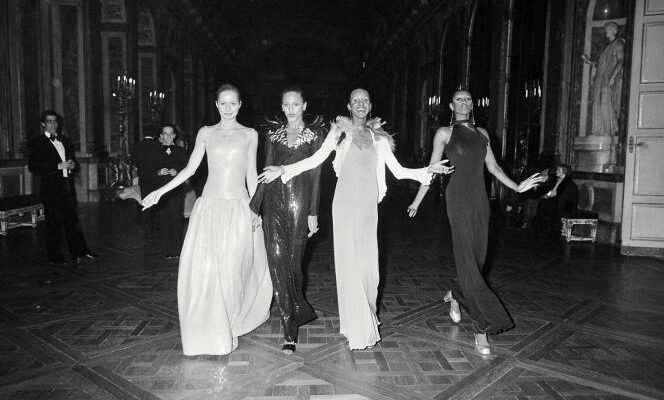Even the most fashion-savvy do not necessarily know what happened in 1973. From this period which seems very distant, they more readily remember the heartbreaking farewells of Cristóbal Balenciaga, in 1968, who will leave Countess Mona von Bismarck for two days cloistered in her room in grief; the death of Coco Chanel, both outdated and unsurpassable, on January 10, 1971; or even the scandal of the Liberation collection, two weeks later, signed Yves Saint Laurent, inspired by the Occupation…
But on November 28, 1973? To rediscover it, it took Robin Givhan (2006 Pulitzer Prize), long-time fashion critic at the Washington Post, where she is now an editorialist, an investigation in order to reconstruct this very special evening in a scholarly book, today finally translated into French, by Séguier editions.
That evening, at the Royal Opera of Versailles, in the north wing, an XXL fashion show was held, bringing together ten designers: five French and five Americans. The operation was set up by the chief curator of the castle, Gérald Van der Kemp, and the whimsical Eleanor Lambert, co-founder, in 1962, of the Council of Fashion Designers of America (CFDA), the federation of American fashion – “ matron overflowing with will », « flirtatious » and “ outstanding diplomat » who “ controlled the American fashion industry from A to Z”, describes Givhan. The goal ? Raise funds for the maintenance of Versailles, thanks to tickets sold for 235 dollars.
Revue dancers and headliners
On 400 pages, it is therefore this great show, comparable to “ a battle », that the journalist revives, from the very first preparations, through the chaotic rehearsals and up to the outcome in front of seven hundred happy few. All this in a context of war in Vietnam, oil crisis, racial riots, liberation of bodies and record drug consumption.
Eleanor Lambert, who wants to give ready-to-wear from across the Atlantic visibility in the land of haute couture, has selected five foals: Oscar de la Renta and his muslin dresses, Bill Blass and his innovative jumpsuits, the egotistical Halston, who creates sensational sequined sheaths (the series devoted to him on Netflix also evokes this historic episode in Versailles), the African-American Stephen Burrows, who anticipates unisex and whose affordable jerseys are so transparent that they hide almost nothing, and finally Anne Klein, a pioneer of sportswear that everyone despises, ignoring the “ secret martyrdom » that she endures, then suffering from breast cancer.
You have 49.34% of this article left to read. The following is for subscribers only.
